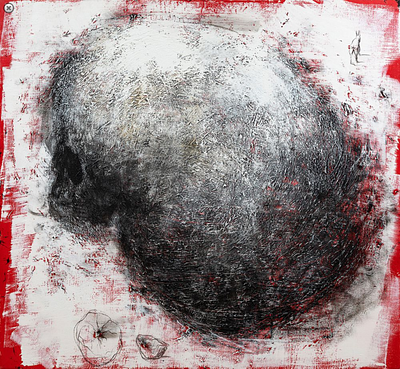OSWALDO GUAYASAMÍN (Quito, Ecuador, 1919 - Baltimore, USA, 1999). "Portrait of Atahualpa, 1945. Oil on canvas. Signed in the lower left corner. At
Lot 88
About Seller
Setdart Auction House
Carrer Aragó 346
Barcelona
Spain
Setdart Subastas was born in 2004 and is currently the first online art auction in Spain with solidity, prestige and reliability guaranteed by our more than 60,000 users. Setdart has a young, dynamic and enterprising team ready to successfully manage the purchase and sale of art works through custom...Read more
Categories
Estimate:
EUR€45,000 - EUR€55,000
$47,872.34 - $58,510.64
Absentee vs Live bid
Two ways to bid:
- Leave a max absentee bid and the platform will bid on your behalf up to your maximum bid during the live auction.
- Bid live during the auction and your bids will be submitted real-time to the auctioneer.
Bid Increments
| Price | Bid Increment |
|---|---|
| EUR€0 | EUR€10 |
| EUR€200 | EUR€25 |
| EUR€500 | EUR€50 |
| EUR€1,000 | EUR€100 |
| EUR€3,000 | EUR€200 |
| EUR€5,000 | EUR€500 |
| EUR€10,000 | EUR€1,000 |
| EUR€20,000 | EUR€2,000 |
| EUR€50,000 | EUR€5,000 |
About Auction
By Setdart Auction House
Oct 19, 2021
Set Reminder
2021-10-19 08:00:00
2021-10-19 08:00:00
America/New_York
Bidsquare
Bidsquare : CONTEMPORARY ART
https://www.bidsquare.com/auctions/setdart-auction-house/contemporary-art-7701
Setdart Auction House sofia@setdart.com
Setdart Auction House sofia@setdart.com
- Lot Description
OSWALDO GUAYASAMÍN (Quito, Ecuador, 1919 - Baltimore, USA, 1999). "Portrait of Atahualpa, 1945. Oil on canvas. Signed in the lower left corner. Attached certificate of authenticity issued by Verenice Guayasamín, president of the Guayasamín Foundation. Measurements: 86.5 x 63 cm; 99 x 76 cm (frame). In this work the author presents us with a portrait of Atahualpa, the last Inca leader. Guayasamín creates a long bust portrait in which the protagonist, dressed in great jewels, looks at the spectator with a serious gesture. The sober gesture, together with the rigidity of the geometric forms and the author's own emphatic line, give the image a great monumentality that is evidence of the sitter's cultural relevance. One of the greatest names in Ecuadorian painting, Oswaldo Guayasamín showed artistic talent even in childhood, and even sold some of his paintings in the Plaza de la Independencia in his native Quito in his early years. Despite his father's opposition, he entered the School of Fine Arts in the Ecuadorian capital to study painting and sculpture at the height of the so-called Four Days' War, a civic-military uprising against the government in the course of which his close friend Manjares was killed. This event, which would later inspire his work "Los niños muertos" ("The Dead Children"), would forever mark his vision of man and society. In 1941 he won the title and First Prize at the Mariano Aguilera Salon in Quito, and the following year he held his first solo exhibition, at the age of twenty-three. This exhibition was controversial, and considered by critics as a confrontation with the official exhibition of the School of Fine Arts. Nevertheless, the American tycoon Nelson Rockefeller, impressed by his work, bought several of his paintings, initiating a relationship that would continue into the future. Between the end of 1942 and the beginning of 1943 Guayasamín was in the United States, and later travelled to Mexico, where he began to work as an assistant to Orozco. He then made a series of journeys through Latin America, always encountering the same situation of oppression of the indigenous society to which he himself belonged. From then on this would be a constant theme in his work. Around this time he focused especially on social themes, and began to simplify the forms, finally arriving at his personal emphatic and expressive style. His work, centred on the human being and described by critics as expressionist, reflects the pain and misery that plague society, and at the same time denounces the violence that dominated the monstrous 20th century, marked by wars, genocides, dictatorships and tortures. During his youth Guayasamín won all the national prizes in his country, and at the age of thirty-six he won the Grand Prize at the III Bienal Hispanoamericana de Arte, held in 1955 in Barcelona. Later he also won the same award at the São Paulo Biennial (1957). Throughout his career, this master exhibited his work individually not only in various Latin American countries, but also in many European countries, the Soviet Union, China and the United States. In addition to easel painting, he painted murals, sculptures and monuments, nowadays present in Quito (monument "A la Resistencia", murals in the Government and Legislative Palaces, the Central University and the Provincial Council), Madrid (Barajas Airport), Paris (UNESCO Headquarters), São Paulo (Latin American Parliament), Caracas (Simón Bolívar Centre), Guayaquil ("A la Patria Joven"). In 1971 Guayasamín was appointed president of the Casa de la Cultura Ecuatoriana, and five years later the Guayasamín Foundation was created in Quito, to which he donated his work and art collections, since he conceived all artistic expression as a heritage of the people. In 1978 he was appointed member of the Real Academia de Bellas Artes de San Fernando in Madrid.
- Shipping Info
-
In-house shipping available. Please inquire at admin@setdart.com.
-
- Buyer's Premium



 EUR
EUR CAD
CAD AUD
AUD GBP
GBP MXN
MXN HKD
HKD CNY
CNY MYR
MYR SEK
SEK SGD
SGD CHF
CHF THB
THB

















